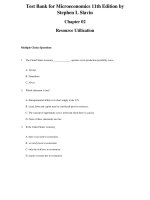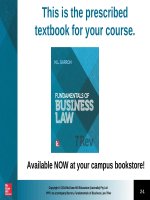Lecture Economics (6/e): Chapter 22 - Stephen L. Slavin
Bạn đang xem bản rút gọn của tài liệu. Xem và tải ngay bản đầy đủ của tài liệu tại đây (418.31 KB, 36 trang )
Chapter 22
Perfect Competition
Copyright 2002 by The McGrawHill Companies, Inc. All rights reserved.
221
Chapter Objectives
•
•
•
•
•
The characteristics of perfect competition
The perfect competitor’s demand curve
The short run and and the long run
Economic and accounting profits
Decreasing, constant, and increasing cost
industries
Copyright 2002 by The McGrawHill Companies, Inc. All rights reserved.
222
Perfect Competition
• Is the first of four competitive modes
• It is a theoretical model that does not exist in
the real world
• This will serve as the standard by which we will
measure the next three competitive models
– Monopoly
– Monopolistic Competition
– Oligopoly
Copyright 2002 by The McGrawHill Companies, Inc. All rights reserved.
223
Definition of Perfect Competition
• There are so many firms that no one firm
is large enough to influence price
– Either by withholding output from the
market or by increasing its output
• The firms are selling an identical product
– A product is identical, in the minds of the
buyers, if they have no reason to prefer one
seller over another
Copyright 2002 by The McGrawHill Companies, Inc. All rights reserved.
224
Definition of Perfect Competition
• The market has perfect mobility
– No barriers to entry such as licenses, long
term contracts, government franchises,
patents, control over vital resources, etc.
– One possible exception is money
• Perfect knowledge about the market exist
– Everyone knows about every possible
economic opportunity
Copyright 2002 by The McGrawHill Companies, Inc. All rights reserved.
225
The Perfect Competitor’s Demand Curve
Firm
Industry
9
S
8
7
6
D,MR
6
5
5
4
4
3
3
2
2
1
1
5
10
15
20 25
Output
30
D
1
2
3
4
5
6
Output (in millions)
7
The intersection of the industry supply and demand curve set the
price that is taken by the individual firm, in this case $6
226
Copyright 2002 by The McGrawHill Companies, Inc. All rights reserved.
The Perfect Competitor’s Demand Curve
Firm
Industry
9
S
8
7
6
D,MR
6
5
5
4
4
3
3
2
2
1
1
5
10
15
20 25
Output
30
D
1
2
3
4
5
6
Output (in millions)
7
The perfect competitor faces a horizontal , or perfectly elastic, demand curve
A firm with a perfectly elastic demand curve has an identical MR curve (MR=P)
Copyright 2002 by The McGrawHill Companies, Inc. All rights reserved.
227
The Perfect Competitor’s Demand Curve
Firm
Industry
9
S
8
7
6
D,MR
6
5
5
4
4
3
3
2
2
1
1
5
10
15
20 25
Output
30
D
1
2
3
4
5
6
Output (in millions)
7
The perfect competitor has to take the market price (it is a price taker!)
Copyright 2002 by The McGrawHill Companies, Inc. All rights reserved.
228
The Perfect Competitor’s Demand Curve
Firm
Industry
9
S
8
7
6
D,MR
5
5
4
6
30/4,000,000 = .0000075
75
10,000,000
3
2
4
D
3
2
1
1
5
10
15 20 25
Output
30
1
2
3
4
5
6
Output (in millions)
7
Why is the individual firm’s demand curve flat instead of sloping down to the right?
The individual firm’s output is between 0 & 30 units. The industry’s output in the millions. It is
impossible for the individual firm to increase output enough to change the price even one cent.
Theoretically, the individual firm’s demand curve slopes down and to the right ever so slightly. But we
can’t see the slope, so we draw it horizontally and consider it perfectly elastic
Copyright 2002 by The McGrawHill Companies, Inc. All rights reserved.
229
The Perfect Competitor in the Short Run
20
MC
18
16
14
12
ATC
10
8
6
D,MR
4
2
0
0
2
4
6
8
10 12
Output
14
16
18
20
In the short run the perfect competitor may make a profit or lose
money
2210
Copyright 2002 by The McGrawHill Companies, Inc. All rights reserved.
The Perfect Competitor in the Short Run
20
MC
18
16
14
12
ATC
10
8
6
D,MR
4
2
0
0
2
4
6
8
10 12
Output
14
16
18
20
Is this firm making a profit or losing money?
Answer: Losing money because the D,MR curve is below the ATC curve
Copyright 2002 by The McGrawHill Companies, Inc. All rights reserved.
2211
The Perfect Competitor in the Short Run
20
MC
18
16
14
12
ATC
10
ATC = $8.50
8
6
D,MR
4
2
0
0
Price = $6
Output = $8
2
4
6
8
10 12
Output
14
16
18
20
How much money is this firm losing?
TP = ( P – ATC) X Output
TP = ($6 $8.50) X 8
TP = $2.50 X 8
TP = $20
Copyright 2002 by The McGrawHill Companies, Inc. All rights reserved.
2212
The Perfect Competitor in the Short Run
20
MC
18
16
14
12
ATC
D,MR
10
8
6
4
2
0
0
2
4
6
8
10 12
Output
14
16
18
20
Is this firm making a profit or losing money?
Answer: Making a profit because the D,MR curve is above the ATC curve
Copyright 2002 by The McGrawHill Companies, Inc. All rights reserved.
2213
The Perfect Competitor in the Short Run
20
MC
Price = $10
18
16
14
12
ATC
D,MR
10
ATC = $8.10
8
6
4
2
0
0
Output = $11
2
4
6
8
10 12
Output
14
16
18
20
TP = ( P – ATC) X Output
TP = ($10 $8.10) X 11
TP = $1.90 X 11
TP = $20.90
Copyright 2002 by The McGrawHill Companies, Inc. All rights reserved.
2214
The Perfect Competitor in the Long Run
Firm
Market
20
20
MC
S
18
18
16
16
14
14
12
12
ATC
10
10
8
8
6
D,MR
6
4
4
2
2
0
0
0
2
4
6
8
10 12
Output
14
16
18
20
D
0
1
2
Output (in millions)
3
In the long run the perfect competitor breaks even
Since the ATC curve lives above the demand curve, the firm is losing money at a
price of $6. How do we then get to the long run where the firm is breaking even?
Copyright 2002 by The McGrawHill Companies, Inc. All rights reserved.
2215
Going from Taking a Loss in the Short Run to
Breaking Even in the Long Run
Firm
Market
20
20
MC
18
18
16
16
14
14
12
S2
S1
12
ATC
10
10
8
D2,MR2
8
6
D1,MR1
6
4
4
2
2
0
0
0
2
4
6
8
10 12
Output
14
16
18
20
D
0
1
2
Output (in millions)
3
At a price of $6 the firm is losing money and so, too, are all the other firms in the
industry
Copyright 2002 by The McGrawHill Companies, Inc. All rights reserved.
2216
Going from Taking a Loss in the Short Run to
Breaking Even in the Long Run
Firm
Market
20
20
MC
18
18
16
16
14
14
12
S2
S1
12
ATC
10
10
8
D2,MR2
8
6
D1,MR1
6
4
4
2
2
0
0
0
2
4
6
8
10 12
Output
14
16
18
20
D
0
1
2
Output (in millions)
3
Some firms leave the industry in the long run pushing the supply down from S 1 to
S2
Copyright 2002 by The McGrawHill Companies, Inc. All rights reserved.
2217
Going from Taking a Loss in the Short Run to
Breaking Even in the Long Run
Firm
Market
20
20
MC
18
18
16
16
14
14
12
S2
S1
12
ATC
10
10
8
D2,MR2
8
6
D1,MR1
6
4
4
2
2
0
0
0
2
4
6
8
10 12
Output
14
16
18
20
D
0
1
2
Output (in millions)
3
This pushes the industry price up to $8. At this price the firm breaks even.
Copyright 2002 by The McGrawHill Companies, Inc. All rights reserved.
2218
Going from Making a Profit in the Short Run to
Breaking Even in the Long Run
Firm
20
Market
20
MC
18
18
16
16
14
14
12
10
ATC
D 1,MR1
8
D2,MR2
S2
12
10
8
6
6
4
4
2
2
0
S1
D
0
0
2
4
6
8
10
12
14
16
18
20
0
1
Output
2
3
Output (in millions)
At a price of $10 all firms in the industry are making a profit
Copyright 2002 by The McGrawHill Companies, Inc. All rights reserved.
2219
Going from Making a Profit in the Short Run to
Breaking Even in the Long Run
Firm
20
Market
20
MC
18
18
16
16
14
14
12
10
ATC
D 1,MR1
8
D2,MR2
S2
12
10
8
6
6
4
4
2
2
0
S1
D
0
0
2
4
6
8
10
12
14
16
18
20
0
1
Output
2
3
Output (in millions)
New firms are attracted into the industry. This increases supply moving the
supply curve from S1 to S2
Copyright 2002 by The McGrawHill Companies, Inc. All rights reserved.
2220
Going from Making a Profit in the Short Run to
Breaking Even in the Long Run
Firm
20
Market
20
MC
18
18
16
16
14
14
12
10
ATC
D 1,MR1
8
D2,MR2
S2
12
10
8
6
6
4
4
2
2
0
S1
D
0
0
2
4
6
8
10
12
14
16
18
20
0
1
Output
2
3
Output (in millions)
This reduces the industry price to $8, at which the firms break even
Copyright 2002 by The McGrawHill Companies, Inc. All rights reserved.
2221
The Perfect Competitor in the Long Run
24
MC
23
22
ATC
21
20
19
Price = ATC
D,MR
18
17
The most profitable level of
output is 11.1
16
15
5
10
Output
15
20
In the long run the firm breaks even
The ATC curve is tangent to the demand curve at the point where MC = MR.
ATC will equal price at the breakeven point (the minimum point on the ATC
curve)
2222
Copyright 2002 by The McGrawHill Companies, Inc. All rights reserved.
The Perfect Competitor in the Long Run
24
MC
23
22
ATC
21
20
19
Price = ATC
D,MR
18
17
The most profitable level of
output is 11.1
16
15
5
10
Output
15
20
A firm operates at peak efficiency when it produces at the minimum point of its
ATC. For the perfect competitor in the long run, the most profitable output is at
the minimum point of its ATC because this is also where MC=MR
Copyright 2002 by The McGrawHill Companies, Inc. All rights reserved.
2223
Efficiency
• A firm operates at peak efficiency when it
produces at the lowest possible cost
– That would be the minimum point of its ATC curve
( the breakeven point)
• For the perfect competitor in the long run, the
most profitable output is at the minimum point
of is ATC curve because this will be where
MC=MR
• Because of the degree of competition, the
perfect competitor is forced to operate at peak
efficiency
– Other forms of competition do not force firms to
operate at peak efficiency
Copyright 2002 by The McGrawHill Companies, Inc. All rights reserved.
2224
Economic and Accounting Profits
• Accounting profits are what is left over
from sales (revenue) after a firm has paid
all of its explicit cost
– Explicit cost is the cost of doing business
• rent, wages, cost of goods sold, fuel, taxes, etc.
Sales
$200,000
Explicit cost 115,000
Accounting Profit 85,000
Copyright 2002 by The McGrawHill Companies, Inc. All rights reserved.
2225









